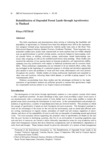Rehabilitation of Degraded Forest Lands through Agroforestry in Thailand
JIRCAS international symposium series
| ISSN | 13406108 |
|---|---|
| 書誌レコードID(総合目録DB) | AA1100908X |

本文フルテキスト
intlsymp-1_92-101.pdf336.75 KB
The field experiments and demonstration plots aiming at indicating the feasibility and desirability of agroforestry in Thailand have been first designed since 1978 in the representative marginal lowland areas characterized by infertile sandy loam soils at the Huey Thar Silvicultural Research Station, Sisaket Province, Northeast Thailand. These long-term comprehensive studies have mostly been concentrated on some systems that are widely adopted such as agrisilvicultural or partial overlap system, one-storey hedgerow intercropping, cyclical planted fallow or shifting cultivation system, multi-storey mixed intercropping, onestorey alley cropping, as well as the modified multi-storey strip planting. These studies also involved the selection of tree species based on biomass production, soil improvement ability, optimum tree-crop combination with respect to fuelwood production and its economic feasibility. These preliminary assessments are riot intended to be an isolated effort, rather, they are envisaged as the beginning of a sustained program to develop and introduce apprppriate pilot models to solve the problems of wood and food crises, deforestation and rural poverty throughout the country. Similar studies are being continuously duplicated and expanded to other sites and locations, following these initial phases, to provide on-going support to the implementation effort.
Evidence accumulating from these studies and the advantages attributed to the implementation of agroforestry systems are sufficient grounds to assume that agroforestry might be a sustainable land-use system in our fragile tropical environments.
Evidence accumulating from these studies and the advantages attributed to the implementation of agroforestry systems are sufficient grounds to assume that agroforestry might be a sustainable land-use system in our fragile tropical environments.
| 作成者 | Pitaya PETMAK |
|---|---|
| 公開者 | Japan International Research Center for Agricultural Sciences |
| オンライン掲載日 | |
| 号 | 1 |
| 開始ページ | 92 |
| 終了ページ | 101 |
| 言語 | eng |
